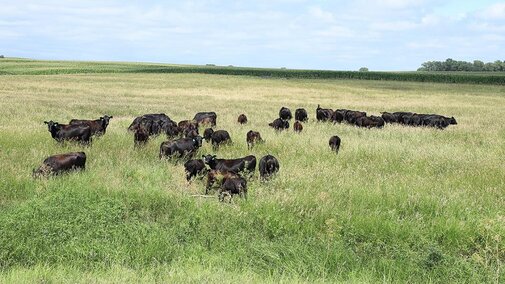Early Spring Grazing to Control Weeds
Pastures are starting to green-up. That is usually a good sign, except when most of the green is coming from weeds.
In warm-season grass pastures, an abundance of early weeds will remove moisture that could be used for grass growth later on and they remove valuable nutrients from the soil. Early weeds also can develop so much growth that they can shade, smother and reduce early growth of your summer pasture grasses.
Herbicides like glyphosate and imazapic (Plateau®) as well as prescribed burning can control many early weeds, but I think another method is actually better — grazing. Heavy, pre-season grazing costs you nothing. In fact, you get some feed from these weeds while herbicides or burning would only kill and remove growth. Plus, this early pasture might be especially valuable if it saves you from feeding expensive hay this spring.
For mixed cool- and warm-season grass pastures, early flash grazing also can be used, but we do want to be a little more cautious as to not overgraze any desirable cool-season grasses. In areas where cheatgrass or downy brome is a problem, grazing at strategic windows — such as during the cheatgrass elongation phase right before seed set — appears to be the best time to apply grazing. Grazing at this time matches diet preference by grazing animals with the cheatgrass growth period and limits over use on perennial cool-season grasses growing at the same time. Targeted grazing is a long-term management option that can utilize cheatgrass as a forage resource and limit the potential seed proliferation within a system.
While early flash grazing of some pastures will not eliminate all the weeds, it can actually make for some pretty timely and valuable pasture.
Trigger Dates
A dry fall and winter has most of Nebraska starting spring in a moisture deficit. As we head into the growing season, assessing pasture conditions at the correct time is critical to successful planning. How can you use trigger dates to inform your drought planning this year?
One of the main factors driving annual forage production in Nebraska’s grazinglands is available moisture. Both cool- and warm-season grasses in the state rely heavily on spring and early summer precipitation at a time when the plant is rapidly growing. This period of rapid growth varies by species and is driven by air temperature, day length, and soil moisture. Once optimal conditions have passed, getting significant growth even if it does rain is difficult.
With this in mind, we can set up some trigger dates to assess moisture levels and pasture conditions, informing the implementation of a drought management plan.
- April 15 to May 10: smooth bromegrass pastures with below average precipitation, annual production may be reduced 25-50%.
- May 20 to June 10: Assess earlier precipitation levels. If March-May precipitation was 50-75% of the long-term average, reduce stocking rates 30-40% or more depending upon grass species and plant health.
- June 15 to June 30: Approximately 75-90% of grass growth on cool-season dominated range sites and 50% of grass growth on warm-season dominated range sites will have happened. Rainfall after late June results in limited benefit to cool-season grass production.
- July 15: Precipitation after this date will have limited benefit to warm-season tallgrass production but can still result in some forage growth from shortgrass warm-season species such as buffalograss and blue grama.
Knowing when to pull the trigger on drought plans is not an easy decision, but it can mean the difference between managing with conditions or scrambling to catch up. This year, use trigger dates for your operation to successfully implement drought mitigation strategies.
Alfalfa Irrigation Before First Cutting
By Brad Schick
Low soil moisture levels in many areas across the state may mean irrigating alfalfa before the first cutting. Many producers have already begun to water alfalfa. Have you considered this moisture building technique?
Early season watering is not a typical practice, but when soil profiles are dry, it needs to be considered. For soil that is still dry from last fall, spring irrigation can build moisture up in the profile for later in the year when the heat of the summer increases water requirements. This practice needs to be taking place now if you haven’t already started.
During the peak of summer heat and growth, alfalfa water needs may reach one half inch per day. Shallow roots are unable to keep up with increased demand during the summer heat. Instead, alfalfa relies upon deep roots that can extend down to depths of eight feet. Spring irrigation will encourage deep root growth now that can be put to use as temperatures climb, tapping into deep soil moisture reserves. On the other hand, if we only irrigate enough to maintain growth in the summer, the development of shallow roots is promoted. This decreases efficiency of summer waterings and may result in a situation where we are physically unable to supply enough water to keep up with moisture needs.
While watering more in these circumstances may seem like a solution, it can actually make things worse. To keep up with summer demand, the soil surface and first few inches may stay too wet. Oxygen needs for roots will be limited and performance will suffer. Alfalfa doesn’t like wet feet.
Finally, adequate subsurface moisture can help control weeds. If irrigating occurs before the alfalfa plant has begun to regrow after cutting, weed growth will be promoted instead.
Water early to make sure the top six feet of soil have ample water for the late spring and summer months.

